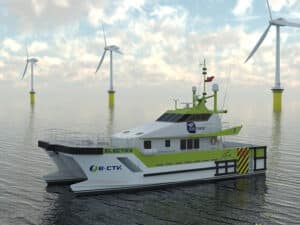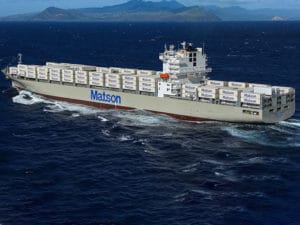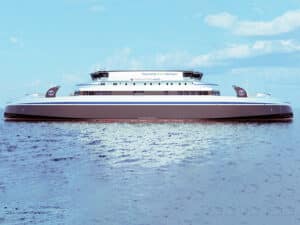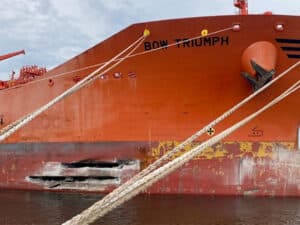
Big questions on costs of Canada’s NSPS
Written by Nick Blenkey FEBRUARY 28, 2013 — A report published today by Canada’s Parliamentary Budget Office (PBO) indicates that the Canadian Government may have massively underestimated the costs of its National Shipbuilding Procurement Strategy (NSPS).
FEBRUARY 28, 2013 — A report published today by Canada’s Parliamentary Budget Office (PBO) indicates that the Canadian Government may have massively underestimated the costs of its National Shipbuilding Procurement Strategy (NSPS).
Though today’s report deals only with the two Joint Support Ships included in the program, it inevitably raises the suspicion that cost estimates for all the ships in the NSPS may be just as inadequate.
Joint Support Ship Concept illustration
So, how big a gap is there between the Department of National Defense (DND) estimate and the PBO figure? The DND estimates the cost of the JSS at $2.53 billion and budgets $2.60 billion.The PBO estimate is $3.28 billion and it says the budget should be $4.13 billion.
Following is an extract from the PBO report’s executive summary:
In 2004, the Government of Canada announced that it would replace the Royal Canadian Navy’s Protecteur-class Auxiliary Oiler Replenishment (AOR) ships. Three Joint Support Ships (JSS) were proposed, with a contract to be awarded in 2008, the first ship delivered in 2012, and the project completed in 2016.1 The Government allocated $2.1 billion to design, develop, and acquire the three ships.
In 2009, however, the Government found that the three ships would not fit within the $2.1 billion budget. In response, the number of ships was reduced to two, delivery dates pushed out, and requirements changed.
The new budget was set at $2.60 billion in fixed nominal dollars. This means that the Government plans to make $2.60 billion available to design and build the ship, with no further adjustments for inflation.
Members [of Parliament] for St John’s East and Scarborough-Guildwood requested the PBO assess the sufficiency of the JSS’s $2.60 billion budget. The PBO developeda parametric cost model for this purpose. As the final characteristics of the JSS are not entirely clear, the PBO estimated the cost of replacing the current Protecteur AORs with two analogous ships built according to Government procurement rules in Canada. All figures in this report are presented in nominal fixed dollars.
Table 1-1: Comparison of DND and PBO Estimates and Budgets for Protecteur Replacement
DND PBO
Estimate $2.53 billion $3.28 billion
Budget $2.60 billion $4.13 billion
DND estimates that replacing the Protecteur will cost about $2.53 billion, and the budget set aside is about $2.60 billion. The PBO’s model suggests that these amounts will be insufficient. It estimates that replacing the Protecteur will cost about $3.28 billion, but that, given the stage of the program and uncertainty surrounding its characteristics, U.S. Government Accountability Office (GAO) best practice recommends budgeting no less than $4.13 billion.
You can read the report HERE
Needless to say, the PBO report makes for uncomfortable reading for all of those with high hopes riding on the National Shipbuilding Procurement Strategy.
SEASPAN “FULLY CONFIDENT”
Seaspan ULC’s CEO Jonathan Whitworth today released the following statement to address concerns raised by the Parliamentary Budget Officer (PBO) about the National Shipbuilding Procurement Strategy (NSPS):
We are confident the NSPS program as described in 2010, as awarded in October 2011, and as signed in the umbrella agreement (UA) on February 14, 2012, is solidly on track.
Since the signing of the UA, Seaspan has realized success in building the right management team, processes and infrastructure to set the yard up for long-term success.
When Seaspan was awarded the Non-Combat program package, we hoped to have secured a design contract in about one year. We signed it last week, four months past the one-year anniversary of the contract award. The design contract for the Offshore Fisheries Science Vessel (OFSV) is the first step in a closely linked series of events that will lead to on-time start of construction next year. During this very important step, we further evolve Canada’s design to include every part and piece of equipment in the ship. This will result in a 3-D electronic product model that includes the production information required to drive the automation and labour processes of our new shipyard facilities.
As we complete the construction-engineering phase we will secure a ship construction contract early next year and begin ship construction in the first Quarter of 2014. Yes, we have had delays, but they are measured in weeks and months, which given that we are embarking on a 20-30 year shipbuilding relationship with the Government of Canada, is a minor inconvenience.
The approach we are using with respect to the new builds themselves is ‘design then build’. It is important to understand that we need to get the designs and production details for each vessel right before we start cutting steel. The ‘design then build’ approach reduces the risks of the actual ship construction process and brings best value to Canada.
Seaspan is excited about this project and would love to begin construction on the new ships immediately, but rushing the process or starting projects prematurely can only create problems for the efficient delivery of vessels. As with the recently completed vessels under the mid-life modernization Frigate Life Extension (FELEX) program at our Victoria Shipyards, we have a strong track record of completing projects on time and on budget. This philosophy will not change under NSPS.
We cannot comment directly on pricing of the Joint Support Ships (JSS) or the Polar Icebreaker yet because we have not gone far enough into the planning or design processes.
In the 17 months since Vancouver Shipyards was awarded the Non-Combat package we have:
-
- Hired 41 engineers, planners, managers and specialists from across Canada and from countries such as Scotland, England, the United States, and Spain to join our project team.
- Received and reviewed more than 5000 resumes so that we are ready to recruit and hire the skilled people we need when shipbuilding starts next year.
- Embarked on a $200 million shipyard modernization program to upgrade our facilities. This is money Seaspan is investing in its own facilities. Work is underway now. Construction companies are on site and progress is being made everyday. Built 7 new chip barges and are in the process of building an additional 2 new gravel barges for sister company Seaspan Marine. These projects were fast tracked to keep our shipyard workers busy honing their skills.
We are also currently:
In the process of developing training and apprenticeship programs with post secondary institutes, and are also formulating strategic partnerships with our local First Nations and other stakeholders to support construction. Working with local municipalities to secure the needed permits and to enhance area roads and access points.
Seaspan added a quote from District of North Vancouver – Mayor Richard Walton:
“Seaspan is a great community partner. The work they are starting under NSPS is transformative for us. We are working well together and making sure we keep up our end of the bargain to ensure Seaspan has the facilities and local infrastructure it needs to start building those great new vessels a year from now.”
Seaspan also quoted Percy Darbyson – Business Representative, Local 506 Marine and Shipbuilders:
“Our members are very excited about NSPS program and are kept fully informed by Seaspan every step of the way as they progress with the Federal Government. NSPS means 20-30 years of solid work for our members. We will trade a minor delay or two upfront to ensure a successful program.”





Leave a Reply
You must be logged in to post a comment.